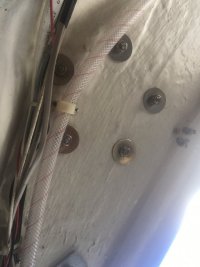While you want to keep the structure good and solid, avoid the temptation to overdo it.
When sailing close hauled, especially when cracking on in a stiff breeze, I am amazed at how tremendously tight the genoa sheet is, and how small the washers are backing up the primary winch bolts/nuts. I know it is set in solid (uncored) fiberglass in the cockpit coaming, but still.
The weight of 5/16" chain and 35lb anchor hanging up and down in 100ft is about 140lb. Even allowing up to 500lb pull to break the anchor out of sticky mud under power, you are well within safety margins (compared to the primary).
The grain of the balsa blocks in a cored deck is usually vertical, the best orientation for compressive strength. The chain locker lid is so thin however that this may not be the case. I would still not suggest overdrilling the holes as preserving the upper skin is vital to layup integrity. Use Neil's method to hog out some balsa and then fill with thickened epoxy. I like to paint balsa with unthickened epoxy first so it wicks into the core. Do this for a few minutes till it stops wicking, then add the filler to the cup.
If you wanted to beef up anywhere, make the "wings" bigger maybe 5" square, to spread the upward force component over more hatch surround.
Rob
When sailing close hauled, especially when cracking on in a stiff breeze, I am amazed at how tremendously tight the genoa sheet is, and how small the washers are backing up the primary winch bolts/nuts. I know it is set in solid (uncored) fiberglass in the cockpit coaming, but still.
The weight of 5/16" chain and 35lb anchor hanging up and down in 100ft is about 140lb. Even allowing up to 500lb pull to break the anchor out of sticky mud under power, you are well within safety margins (compared to the primary).
The grain of the balsa blocks in a cored deck is usually vertical, the best orientation for compressive strength. The chain locker lid is so thin however that this may not be the case. I would still not suggest overdrilling the holes as preserving the upper skin is vital to layup integrity. Use Neil's method to hog out some balsa and then fill with thickened epoxy. I like to paint balsa with unthickened epoxy first so it wicks into the core. Do this for a few minutes till it stops wicking, then add the filler to the cup.
If you wanted to beef up anywhere, make the "wings" bigger maybe 5" square, to spread the upward force component over more hatch surround.
Rob

